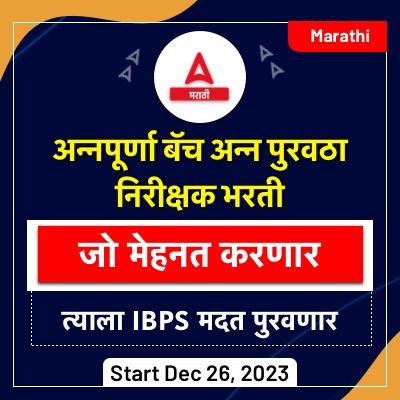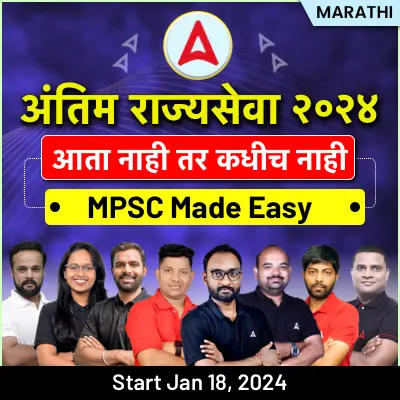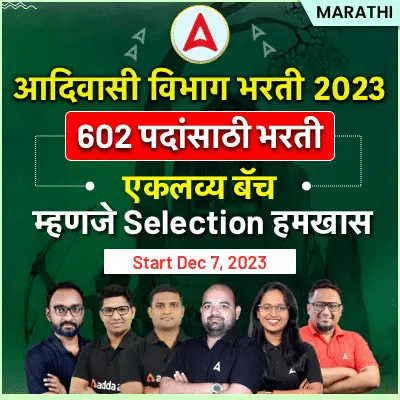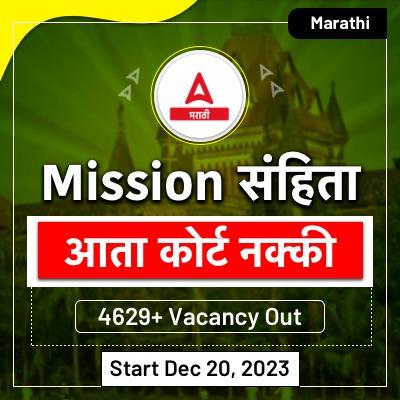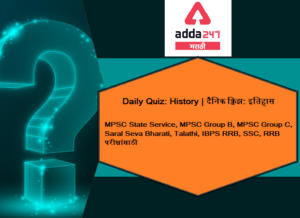
इतिहास दैनिक क्विझ मराठीमध्ये: 26 मे 2021
महाराष्ट्र राज्य लोकसेवा आयोग दरवर्षी वेगवेगळ्या परीक्षे मार्फत हजारो विद्यार्थ्यांची भरती करून घेते MPSC State Service, MPSC Group B, MPSC Group C, Saral Seva Bharati, Talathi, UPSC, SSC, RRB अशा अनेक परीक्षांमार्फत हजारो जागांची भरती दरवर्षी निघते ज्यात लाखो इच्छुक हजार किंवा त्याहूनही कमी जागांसाठी अर्ज करतात. आपण एमपीएससी आणि इतर परीक्षाची तयारी करत असाल तर आपल्याला क्विझ देण्याचे महत्त्व माहित असलेच पाहिजे. बर्याच विद्यार्थ्यांना अभ्यासाचे पुरेसे तास दिले जात असतानाही त्यांना या परीक्षांची पूर्तताही करता आली नाही कारण ते त्यांचे परीक्षण वेळेवर पूर्ण करू शकत नाहीत आणि संशोधन करण्याचा उत्तम मार्ग म्हणजे त्या संबंधित विषयाची किंवा विषयाची क्विझ देणे कारण आपण या मार्गाने कव्हर करू शकता कमी वेळात जास्तीत जास्त विषय. आम्हाला Add 247 मराठी येथे चांगल्या अभ्यास सामग्रीचे मूल्य समजले आहे आणि म्हणूनच आम्ही सर्व विषयांसाठी आपल्याला क्विझ प्रदान करीत आहोत. दैनिक क्विझ देऊन तुम्ही तुमच्या तयारीची पातळी तपासू शकता.
चालू घडामोडी, भूगोल, अर्थशास्त्र, पर्यावरण, सामान्य विज्ञान, इतिहास, पॉलिटी अशा सर्व स्पर्धात्मक सामान्य अभ्यास विषयांमध्ये इतिहासाचाही महत्वाचा वाटा आहे. तर चला इतिहास बद्दल तुमची तयारी तपासण्यासाठी खालील 26 मे 2021 ची इतिहासाची दैनिक क्विझ पहा.
Q1. सूफी हालचालींबाबत खालील विधानांचा विचार करा
1. सुफी लोक धर्मशास्त्राच्या कुरआनच्या स्पष्टीकरणाचे कट्टर समर्थक होते.
2. सर्व ऑर्डरच्या सूफ्यांनी ‘सुन्नी’ कायद्यांचा भंग केला
वर दिलेले कोणते विधान/विधाने बरोबर आहे/ आहेत?
(a) फक्त 1
(b) फक्त 2
(c) दोन्ही 1 आणि 2
(d) 1 किंवा 2 देखील नाही
Q2. खालीलपैकी कोणत्याने गदर चळवळीवर परिणाम केला नाही?
(a) कोमागत मारूची घटना
(b) पहिल्या महायुद्धाचा उद्रेक
(c) सिंह सभा आंदोलन
(d) लाला हरदयालची अटक
Q3. दिल्ली सुलतानत संदर्भात खालील विधानाचा विचार करा.
1. महसूल गोळा करणे आणि कायदा व सुव्यवस्थेची देखभाल करण्याची जबाबदारी इक्तेदारांवर होती.
2. इक्तेदारांना जमीन अनुवंशिक अधिकार म्हणून देण्यात आलेली नव्हती कारण इकता आणि सुलतान कधीही परत घेऊ शकतील.
वर दिलेले कोणते विधान/विधाने बरोबर आहे/ आहेत?
(a) फक्त 1
(b) फक्त 2
(c) दोन्ही 1 आणि 2
(d) 1 किंवा 2 देखील नाही
Q4. वेदाराण्यम सत्याग्रह संबंधित खालील विधानांचा विचार करा
1. भारतातील ब्रिटीश राजांनी नील लागवडीचा निषेध करण्यासाठी वेदरन्याम सत्याग्रह आयोजित केले होते.
2. सी. राजगोपालाचारी या चळवळीचे प्रमुख होते
वर दिलेले कोणते विधान/विधाने बरोबर आहे/ आहेत?
(a) फक्त 1
(b) फक्त 2
(c) दोन्ही 1 आणि 2
(d) 1 किंवा 2 देखील नाही
Q5. खजुराहो संबंधित खालील विधानांचा विचार करा,
1. त्यांना चंदेला राजवंशाने संरक्षित केले.
2. ते हिंदू आणि जैन दोन्ही आहेत.
वर दिलेले कोणते विधान/विधाने बरोबर आहे/ आहेत?
(a) फक्त 1
(b) फक्त 2
(c) दोन्ही 1 आणि 2
(d) 1 किंवा 2 देखील नाही
Q6. खालीलपैकी कोणी ईस्ट इंडियन असोसिएशन स्थापना केली?
(a) दादा भाई नौरोजी
(b) गोपाळ कृष्ण गोखले
(c) सुरेंद्र नाथ बॅनर्जी
(d) अरबिंदो घोष
Q7. देसाई लियाकत करारासंबंधी खालील विधानांचा विचार करा:
1. कॉंग्रेस आणि लीगने केंद्रात अंतरिम सरकार स्थापन करण्याचे मान्य केले होते.
2. अंतरिम सरकारसाठी नामित झालेल्या व्यक्तींनी केंद्रीय विधानसभेचे सदस्य नसावे.
वर दिलेले कोणते विधान/विधाने बरोबर आहे/ आहेत?
(a) फक्त 1
(b) फक्त 2
(c) दोन्ही 1 आणि 2
(d) 1 किंवा 2 देखील नाही
Q8. माउंटबेटन योजनेसंबंधी खालील विधानांचा विचार करा:
1. वायव्य सीमावर्ती प्रांत पाकिस्तानमध्ये विलीन होईल
2. आसाममधील सिल्हेटचे लोक बंगालमधील मुस्लिम भागात सामील होण्यासाठी इच्छुक आहेत की नाही हे जनमत संग्रहात आपला निर्णय देतील.
वर दिलेले कोणते विधान/विधाने बरोबर आहे/ आहेत?
(a) फक्त 1
(b) फक्त 2
(c) दोन्ही 1 आणि 2
(d) 1 किंवा 2 देखील नाही
Q9. सातवाहना राज्यकर्त्यांविषयी खालील विधानांचा विचार करा.
1. त्यांनी ब्राह्मण असल्याचा दावा केला.
2. त्यांनी चौपदरी वर्ण ऑर्डर दिली.
3. ते त्यांच्या आईच्या नावावरून ओळखले गेले परंतु वारसाहक्क पितृत्व होते.
वर दिलेले कोणते विधान/विधाने बरोबर आहे/ आहेत?
(a) 1 आणि 2
(b) 2 आणि 3
(c) 1 आणि 3
(d) 1, 2 आणि 3
Q10. मिथिला चित्रकला संबंधित खालील विधानांचा विचार करा
1. बिहारच्या मैथिली चित्रकलेचे विषय हिंदू देवतांच्या आसपास फिरतात
2. वापरल्या जाणार्या नैसर्गिक थीममध्ये सूर्य, चंद्र आणि तुळशीसारख्या धार्मिक वनस्पतींचा समावेश आहे.
3. मुख्य थीम रंगविल्यानंतर कोणतीही रिक्त जागा शिल्लक राहिल्यास ती फुले, प्राणी आणि पक्षी किंवा भूमितीय रचनांनी भरलेली आहे.
वर दिलेले कोणते विधान/विधाने बरोबर आहे/ आहेत?
(a) 1 आणि 2
(b) 2 आणि 3
(c) 1 आणि 3
(d) 1, 2 आणि 3
महाराष्ट्र राज्यातील सर्व स्पर्धा परीक्षांचे मोफत अभ्यास साहित्य
YouTube channel- Adda247 Marathi
App- Adda247 (मराठी भाषा)
Use Coupon code: HAPPY
आणि मिळवा 75% डिस्काउंट
आता तुमच्या घरी लाइव्ह वर्ग मराठीत उपलब्ध आहेत
केवळ सरावच परीक्षेत चांगले गुण मिळण्यास मदत करू शकतो
SBI लिपिक फाउंडेशन बॅच | द्विभाषिक
Solutions
S1.Ans.(d)
Sol.
The Sufis were critical of the dogmatic definitions & scholastic methods of interpreting the Quran and ‘Sunna’ (traditions of Prophet) adopted by the theologians. Instead, they laid emphasis on seeking salvation through intense devotion & love for God.
Some Sufis initiated movements against radical interpretations of Sufi ideas. They ignored rituals & practised extreme asceticism, observed celibacy, etc. they were known by different names like – ‘Qalandars’, ‘Madaris’, ‘Malangs’, ‘ Haidaris’, etc. Because of their deliberate defiance of sharia, they were known as ‘be-sharia’, in contrast to those Sufis who complied with the sharia (ba-sharias).
S2.Ans.(c)
Sol.
Three events influenced the course of the Ghadar movement: the arrest and escape of Har Dayal, the Komagata Maru incident and the outbreak of the First World War.
The Singh Sabha Movement was a Sikh movement that begun in the late 19th century. The movement’s aims were the revival of the Sikh Gurus’ teachings, the production of religious literature in the Punjabi language using the Gurmukhi script. It did not impact the Ghadar movement.
S3.Ans.(c)
Sol.
Initially, the Delhi Sultans had divided their empire into several ̳Iqtas ̳ or provinces or spheres of influence and put them under the charge of officers called ̳Iqtadars ̳ (governors).
Duties and powers of the Iqtadar:
- He was under the supervision of the Central government and carried on orders of the Sultan.
He collected revenue from the people of his territory.
- From the revenue thus collected he administered expenditure on the maintenance of his army, his pay and other administrative expenditure and deposited the rest in the state treasury.
- The Iqtadar did not enjoy hereditary powers. The Sultan could take back Iqta from him whenever he pleased.
S4.Ans.(b)
Sol.
The Vedaranyam March or Vedaranyam Satyagraha was organised to protest the salt tax imposed by the British Raj in India. The march took place in April 1930 and was the second of its kind following the Dandi March organised by Mahatma Gandhi, both in the framework of the Civil Disobedience Movement. The march was led by a group of 100 volunteers from the Indian National Congress (INC) under the leadership of C. Rajagopalachari-often referred to as “Rajaji”. It began at Trichinopoly (now Tiruchirappalli) and ended in Vedaranyam, a small coastal town in
Tanjore District
S5.Ans.(c)
Sol.
The temples at Khajuraho were built during the Chandella dynasty, which reached its apogee between 950 and 1050. Only about 20 temples remain; they fall into three distinct groups and belong to two different religions – Hinduism and Jainism.
The Khajuraho temples are made of sandstone, with a granite foundation that is almost concealed from view.
S6.Ans.(a)
Sol.
Dadabhai Naoroji was born into a leading Parsi family in Bombay. In 1855 Naoroji became a partner in an important Parsi commercial firm in London, and in 1862 he set up his own commercial house there. In the same year, he founded the influential East Indian Association to educate the English public on Indian affairs.
S7.Ans.(c)
Sol.
According to the Desai Liaquat Pact: the Congress and the League had agreed to form an interim government in the Centre. The composition of such a government would be on the following lines:
- an equal number of persons nominated by the Congress and the League. The persons nominated needs not be members of the Central Legislature.
- Representatives of the minorities especially the Scheduled Castes and the Sikhs, and The Commander-in-Chief. The Government would function within the framework of the existing Government of India Act.
S8.Ans.(b)
Sol.
Lord Mountbatten worked out a detailed plan for the transfer of power to the Indian people.
The salient features of the Mountbatten plan were as follows:
- Muslim-dominated areas may be separated to form a Dominion In that case such domination would be constituted by a partition of Bengal and Punjab.
- A referendum in North-west Frontier Province would decide whether it should join Pakistan or not.
- Similarly the people of Sylhet, in Assam, were also to give their verdict in a referendum whether they were willing to join the Muslim area in Bengal.
- A Boundary Commission was to define the boundaries of the Hindu and Muslim Provinces in the Punjab and Bengal
- The British Parliament was to legislate an Act for the immediate transfer of power. (6) The representatives of the Muslim-dominated areas could form a separate Constitution-making body or Constituent Assembly.
S9.Ans.(d)
Sol.
According to the Shastras, only Kshatriyas could be kings. However, several important ruling lineages probably had different origins. Satavahana claimed to be Brahmans. The most famous ruler, Gotamiputa Shri-Satakani, claimed to be both a unique Brahmana (eka bamhana)and a destroyer of the pride of Kshatriyas.
They upheld the fourfold Varna order but entered into a marriage alliance outside the Varna System.
Satavahana rulers were identified through metronymics (names derived from that of the mother) however succession to the throne was generally patrilineal.
S10.Ans.(d)
Sol.
Mithila painting (also known as Madhubani Painting) originated in a small village, known as Maithili, in the Bihar state of India.
- The themes of the Maithili painting of Bihar revolve around Hindu deities like Krishna, Rama, Lakshmi, Shiva, Durga, and Saraswati. The natural themes that are used include the Sun, the Moon and religious plants like tulsi.
- The painting was traditionally done on freshly plastered mud walls and floors of huts, but now they are also done on cloth, handmade paper and canvas.
- One can also find paintings based on scenes from the royal courts and social events, like weddings. If any empty space is left after painting the main theme, it is filled up with the motifs of flowers, animals and birds or geometric designs.



